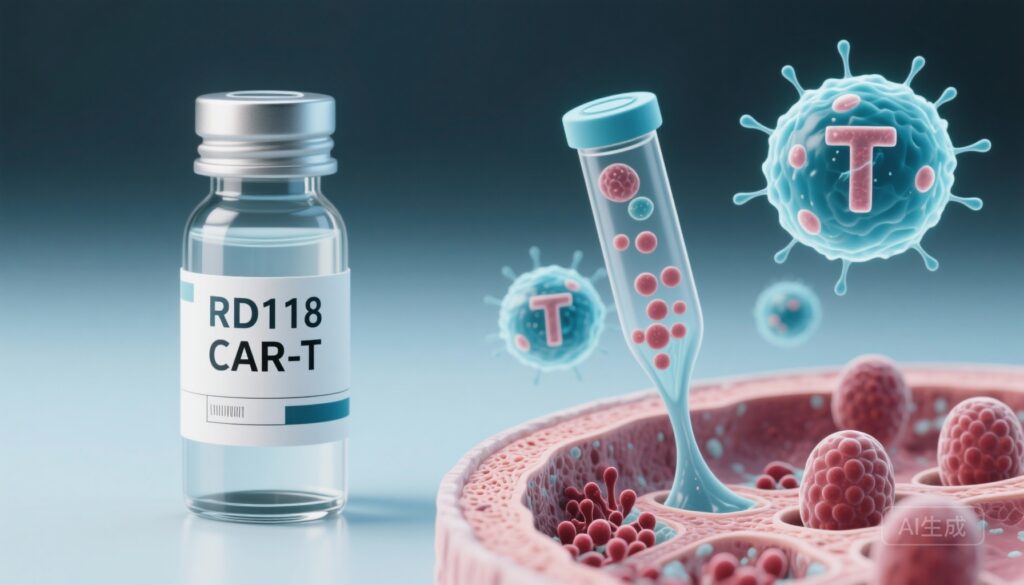Highlight
RD118, a fully human single-domain antibody (VHH) anti-GPRC5D CAR T, produced a 94.4% overall response rate (ORR) and 72.2% complete/ stringent complete responses (CR/sCR) in 18 relapsed/refractory multiple myeloma (RRMM) patients, with a median progression-free survival (PFS) of 18.2 months and mainly low-grade cytokine release syndrome (CRS).
Background and Unmet Need
Multiple myeloma remains largely incurable despite successive therapeutic advances, including proteasome inhibitors, IMiDs, monoclonal antibodies, bispecific T-cell engagers and chimeric antigen receptor (CAR) T-cell therapies targeting B-cell maturation antigen (BCMA). Durable remissions are achievable for many, but patients who relapse after BCMA-directed therapies have limited effective options. Antigen loss or downregulation (BCMA-negative relapse) and T-cell fitness/immune escape contribute to post–BCMA therapy failures. Alternative target antigens expressed on malignant plasma cells are therefore a high priority.
G protein–coupled receptor class C group 5 member D (GPRC5D) is a transmembrane receptor with relatively restricted expression profile, enriched on plasma cells and limited normal-tissue expression, making it an attractive target for immunotherapy in multiple myeloma. GPRC5D-directed modalities, including bispecifics (e.g., talquetamab) and CAR T constructs, have emerged as promising strategies, particularly for patients who have progressed after BCMA-directed therapy.
Study Design
This phase 1, dose-escalation study evaluated RD118, a fully human single-domain antibody fragment (VHH)-based CAR targeting GPRC5D. Eighteen patients with relapsed/refractory disease (17 with multiple myeloma, 1 with prior primary plasma cell leukemia) received a single infusion of RD118 at one of three dose levels: 1.0 × 10^6, 2.0 × 10^6, or 3.0 × 10^6 CAR+ T cells/kg. The trial evaluated safety, tolerability, expansion/persistence of infused cells, and efficacy outcomes including ORR, depth of response (including CR/sCR), progression-free survival (PFS), and overall survival (OS). Median follow-up was 17.0 months. ClinicalTrials.gov identifiers: NCT05759793 and NCT05219721.
Key Findings
Efficacy
– Overall response rate (ORR): 94.4% (17/18 patients) following a single infusion of RD118.
– Complete or stringent complete responses (CR/sCR): 72.2% of patients achieved CR or sCR, indicating deep remissions in the majority of responders.
– Prior BCMA exposure: Among seven patients previously treated with BCMA-directed CAR T-cell therapy, ORR was 85.7%, demonstrating activity in a cohort with prior BCMA-directed failures.
– Progression-free survival (PFS): Median PFS was 18.2 months (95% CI, 14.4–not estimable), with a 12-month PFS rate of 82.1%.
– Overall survival (OS): 12-month OS was 93.3% at a median follow-up of 17.0 months; median OS was not reached.
Safety and tolerability
– Cytokine release syndrome (CRS) occurred in 88.9% of patients, predominantly grade 1–2. CRS was managed with standard interventions (supportive care, anti–IL-6 therapy and/or steroids as clinically indicated).
– Neurotoxicity: One patient developed grade 3 immune effector cell–associated neurotoxicity syndrome (ICANS) that resolved within 72 hours. No other grade ≥3 neurotoxicity events were reported.
– Notably, no cerebellar toxicities—an entity reported with some CAR T products—were observed, and there were no treatment-related deaths.
– On-target, off-tumor toxicities classically associated with GPRC5D-directed therapies (e.g., cutaneous, nail or taste disturbances) were not prominent in the reported safety summary; detailed adverse-event tables will be important in the full report.
Pharmacodynamics and biologic observations
– The fully human VHH (single-domain) binding moiety is intended to reduce immunogenicity compared with non-human or humanized constructs and may influence in vivo persistence and tolerability. The report suggests clinically meaningful durability of response with median PFS >18 months in a heavily pretreated cohort.
Clinical significance
These results suggest RD118 achieves high response rates and deep remissions in a small cohort of heavily pretreated RRMM patients, including those who previously received BCMA CAR T therapy. The magnitude and durability of responses, coupled with a manageable safety profile dominated by low-grade CRS, are promising for a phase 1 program.
Expert Commentary and Context
Place in the evolving treatment landscape
RD118 adds to a growing arsenal of non–BCMA-directed cellular therapies for multiple myeloma. For patients who relapse after BCMA-targeted therapy, targeting an alternative antigen such as GPRC5D is a rational strategy to overcome antigen-loss mediated resistance. High ORR and deep response rates in this phase 1 dataset underscore GPRC5D’s value as a target and highlight the potential of fully human VHH-based CAR designs to combine potency and tolerability.
Mechanistic considerations
– VHH single-domain antibodies are smaller than conventional scFv fragments, which can confer benefits such as improved tissue penetration and different epitope engagement. Fully human sequences may reduce anti-CAR immune responses, potentially enhancing persistence.
– GPRC5D expression is relatively restricted, which reduces—but does not abolish—the risk of on-target off-tumor toxicity. Ongoing correlative analyses (e.g., antigen density, soluble GPRC5D if present, and immune-profile changes) will clarify mechanisms of response and resistance.
Safety nuances
– The predominance of grade 1–2 CRS is reassuring. The single transient grade 3 ICANS contrasts with higher or delayed neurotoxicity signals reported with some CAR products and suggests a favorable neurotoxicity profile, though larger datasets are required.
– Vigilant monitoring for dermatologic, mucocutaneous, or taste-related events is warranted, given mechanistic expectations from other GPRC5D-targeted modalities.
Limitations and generalizability
– Small sample size (n=18) and early-phase single-arm design limit the certainty of efficacy estimates and the ability to detect less common safety events.
– Follow-up (median 17 months) is encouraging but longer maturation is necessary for robust OS and late-toxicity assessment.
– Details on manufacturing success rates, time from leukapheresis to infusion, bridging therapy use, and proportion screened versus infused are essential for real-world applicability but were not detailed in the summary.
Implications for Clinical Practice and Future Research
– RD118 merits further clinical development in larger, multicenter studies with prespecified cohorts of patients pretreated with BCMA-directed therapies and in earlier lines of therapy.
– Comparative studies or randomized platforms could help define RD118’s relative benefit versus existing CAR T and bispecific options.
– Combination strategies (e.g., checkpoint modulation, dual-targeted CARs, or sequential antigen targeting) and optimization of dosing/scheduling should be explored to prolong remission duration and prevent antigen escape.
– Correlative studies to examine CAR persistence, phenotype of circulating CAR T cells, antigen expression dynamics in marrow and extramedullary sites, and mechanisms of relapse will be critical to inform next steps.
Conclusion
RD118, a fully human VHH-based anti-GPRC5D CAR T-cell therapy, demonstrated high response rates (ORR 94.4%), deep remissions (CR/sCR 72.2%), and a median PFS of 18.2 months in a heavily pretreated cohort of 18 RRMM patients with manageable toxicity dominated by low-grade CRS. Activity in patients previously exposed to BCMA CAR T cells supports GPRC5D as a valid alternative target. These encouraging phase 1 results warrant expedited evaluation in larger, multicenter trials to confirm efficacy, characterize safety in broader populations, and define RD118’s role in the post-BCMA treatment landscape.
Funding and ClinicalTrials.gov
The study is reported with ClinicalTrials.gov identifiers NCT05759793 and NCT05219721. Funding sources were not detailed in the summary; refer to the published article for sponsor, funding, and conflict-of-interest disclosures.
References
1. Pan M, Wang D, Xu J, et al. Fully Human anti-GPRC5D CAR T-Cell Therapy RD118 Induces Durable Remissions in Relapsed/Refractory Multiple Myeloma. Blood. 2025 Oct 21:blood.2025030559. doi:10.1182/blood.2025030559. PMID: 41118600.
2. Munshi NC, Anderson LD Jr, Shah N, et al. Idecabtagene vicleucel in patients with relapsed and refractory multiple myeloma (KarMMa): a multicentre, open-label, phase 2 trial. N Engl J Med. 2021;384(8):705–716.
(Readers should consult the full Blood article for complete methodology, adverse-event tables, correlative studies and disclosure statements.)



